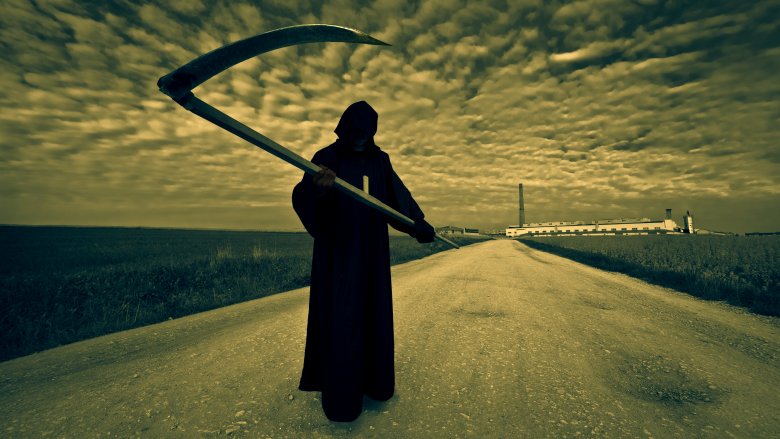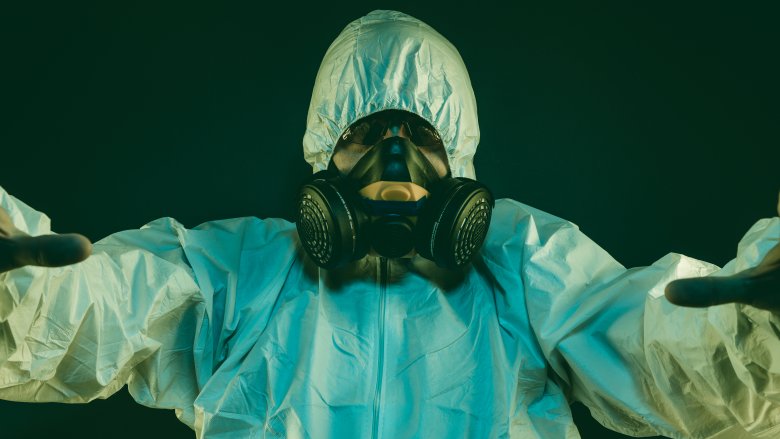Why You'd Never Survive The Worst Plagues In History
For as long as humankind has been keeping records, there have been stories of plagues. The medieval Black Death might be the most infamous one, but it definitely wasn't the only one. There were other outbreaks, too, like a 17th-century plague that killed one in five Londoners. And then there's the sickness that came out of China and wasn't declared officially over until 1959. National Geographic says that the very first one that shows up in any well-documented depth was the Plague of Justinian, which killed around 10,000 people each and every day in 6th-century Constantinople.
And that's just the horrifying disease that officially carries the name of plague, like the bubonic plague and the almost 100 percent fatal pneumonic plague and septicemic plague. There are other outbreaks that have been described as plague, too — terrifying illnesses that kill in painful, horrible ways.
Of course, without seeing the death and devastation of plagues past, it's easy to think you'd have a decent chance of survival. Honestly, we all think that. It's why we always cast ourselves as the survivors in our zombie fantasies, even though statistically, the dead will outnumber the living. And if you were caught in a real-life plague, well, it probably wouldn't turn out so well. From food shortages to bad neighborhoods, these are the reasons why you'd never survive the worst plagues in history.
You were already weakened by famine
No one really knows how many people were killed when the Black Death swept across Europe in the Middle Ages. National Geographic says it was about a third of Europe's population, while The Harvard Gazette says it could've been as high as half. But why was the plague so devastating? Well, maybe because when it kicked off in 1347, people were already weakened by starvation and famine.
Harvard researchers found that both written records and ice-core data show years of famine and lean times in the decades leading up to the plague. Prolonged periods of cold, wet weather over huge parts of Europe led to massive food shortages, and people already starving and weak would've been easy pickings for the plague.
Lynn Harry Nelson, emeritus professor of medieval history at the University of Kansas, says that a wet spring in 1315 and a cold, wet 1316 did so much damage to Europe's agricultural landscape that by 1317, things were so dire that the elderly portion of the population was voluntarily starving to death so the younger might have more. It took years for the food supply to recover, and it was about the same time "normal" returned that the Black Death hit.
You don't know who's contagious
At a glance, it might seem like surviving one of history's plagues should be pretty easy. Travel went a lot slower then, and it seems like there might be plenty of time to just shut down the roads. But it's more complicated than that, because of the difference between when symptoms show and when someone is contagious.
Take Ebola, for example. The World Health Organization says the disease has an incubation period of anywhere from two to 21 days. However, people aren't contagious until they start experiencing symptoms. It's easy to take precautions then, right?
Well, other illnesses are a little more tricky. The Center for Disease Control and Prevention (CDC) warns that anyone who's come down with the flu is most contagious in the few days they're actually sick, but they can be contagious at least a day or so before symptoms start. Given how easily it spreads, well, that just makes it harder to keep away from the infected.
What about the plague? The CDC says that there's a delay of anywhere from one to six days between being infected and showing symptoms. Even in the Middle Ages, someone could cover a decent amount of distance in six days. And by then, it was too late. They'd brought the plague to your village and moved on, leaving death and destruction behind them.
You can't age out of the plague
Whenever there's an outbreak of anything from the flu to E. coli, the same warnings are usually repeated. The very young and the very old are usually in the highest risk groups (along with those who have compromised immune systems). But plague can play by different rules.
According to research done by Pennsylvania State and University of Albany anthropologists (via LiveScience), not everyone had equal chances of living or dying of the Black Death. Those who were of a more delicate constitution were more likely to die, and that included children, the elderly, and people in the prime of their life but suffering from another illness or living in famine conditions.
It's entirely different when it's the flu. When the Spanish flu broke out in 1918, it killed a high percentage of people who were between 20 and 40. According to research done at the University of Arizona (via The Atlantic), that's because that age group was exposed to one particular type of flu during childhood. However, those flu strains morphed into something different, and since they'd never been exposed to anything like it before, the victims had no immunity.
It's happened in recent history, too. Outbreaks of H5N1 predominantly impacted younger victims, because those born after 1968 lacked childhood experience with that flu strain.
You'd be exposed to all sorts of nasty stuff
Influenza is common, but there have been periods in history where it's been pretty deadly, too. In 1918, Spanish flu killed somewhere between 40 and 50 million people, in what the BBC says is often referred to as the "greatest medical holocaust in history".
There were a few things going on at the time that made it unlikely you'd survive if you came down with the Spanish flu. Not only was the idea of a virus a fairly new thing, but this was all set against the backdrop of World War I. And that was dangerous for a few reasons.
Daily life was horrible, both for soldiers on the front lines and for those at home. The trenches in particular were the perfect places for diseases to multiply. Then add in vitamin deficiencies, malnourishment, and other infections and injuries. That's a recipe for disaster.
Plus, every soldier was fighting in close proximity to people from places they'd never been to, carrying things they had never been exposed to. Even if that guy from the US, the one from the UK, and the one from Greece knew they were all on the same side, if one had a cold, the others were going to be particularly susceptible to it as they'd never been exposed to anything like it before. Take that, put it on a global scale, and that's a recipe for an influenza outbreak of catastrophic proportions.
You probably weren't educated enough to survive the worst plagues
There was no internet during some of the biggest and deadliest plagues, that's a given. But there also wasn't a great way to spread information faster than disease, even when officials knew what was coming.
And that's not just a comment on the Middle Ages and the Black Death, either. According to the BBC, historians analyzed the spread of Spanish flu in 1918, and when they isolated records from Chicago as a sample group, they found a surprising link between illiteracy and the likelihood of death.
That's possibly because the more illiterate parts of the population had less access to medical resources, but that's not the whole story. Public health officials across the city were doing their best to get word out about best practices to stay healthy and safe, and those included things like instituting a city-wide quarantine, closing schools, and temporarily banning large-scale social gatherings. But taking out an ad in the newspaper or posting signs doesn't help the people who can't read them. Go back to older plagues, and the chances of being illiterate and uneducated — and therefore unable to understand or interpret the people trying to help you — were even higher.
You can't escape the dead
According to Vice, the plague of the Black Death variety wasn't actually spread by coming into contact with the dead. It was, however, spread by the almost inevitable fleas and lice that were on the bodies of the dead, so there's that. And those corpses? They piled up, literally, so if you lived in a city, you weren't getting away from them.
Chronicles from the era paint a dismal picture, with one Florentine writer relating (via History Today) that the poor were gathered up, thrown into a pit, then covered with a layer of dirt to prepare for the next round of dead. The dirt wasn't always enough to dissuade the animals, though, with Agnolo di Tura writing about those "so sparsely covered with earth that the dogs dragged them forth and devoured many bodies throughout the city."
It wasn't just an old-timey problem. When the plague broke out in Madagascar in 2017, officials were trying to put an end to a ritual called "famadihana", or dancing with the dead. It's exactly what it sounds like, and health officials were asking residents to please stop removing the bodies of plague victims from their graves and dancing with them, for fear of spreading the disease further (via LiveScience).
The plague has perfected methods of killing
Bubonic plague isn't just something nasty that exists and kills people. It's actually something that started off as mildly dangerous and mutated into exactly what would kill the most efficiently. Is that worse? Yes ... yes, it is.
According to research from Cambridge's Leverhulme Centre for Human Evolutionary Studies (via Medical Daily), plague bacteria has been found in the DNA of people who died roughly 5,783 years ago. Until these findings, it was believed plague appeared only about 1,500 years ago, and that brings up a huge question: When were the other times that plague wiped out a huge percentage of the population?
Well, that didn't happen, because the ancient version of the plague was much less virulent. The truly deadly one appeared at some time in the late second to early first millennium BC, when the ancient strain mutated into something that made it so destructive. National Geographic says this mutant strain acts in a particular way. It first attacks a host's immune system, and destroys the cells that are responsible for pinpointing bacterial infections. Then the bacteria multiplies freely, and those pus-filled sacs that form? Those are collections of bacteria, waiting to be picked up by a friendly neighborhood flea and be passed on to the next person. It's ridiculously efficient, and what chance would you have against something that's mutated specifically to multiply through you?
Sometimes, people were trying to infect you on purpose
The plague — whether it was the plague, the flu, or something else entirely — was difficult enough to avoid when it was spread by fairly natural means. Add in the fact that sometimes people were trying to spread it to certain populations on purpose, and it became even more deadly.
Take smallpox, for example. The National Center for Biodefense says it was in the 14th century that the Tartars used it as a weapon, hurling bodies of smallpox victims into towns to spread the disease and sicken the population, leaving the town ripe for the taking.
Something similar was done during the French and Indian Wars of the mid-18th century, when British commanders ordered that the blankets used by smallpox victims be distributed among Native American tribes. The results were devastating, and of all the tribes that were infected, they suffered about a 50 percent mortality rate.
But why smallpox? Because it was incredibly deadly to an entire section of the globe that had no previous exposure to it. When Hernán Cortés and his men kicked off their crusade against the Aztecs, they introduced smallpox and decimated the population from 30 million in 1519 to between 1.5 and 3 million in 1619 (via Past Medical History). If it was that deadly when people weren't even trying to spread it, imagine what it could do if it was released on purpose.
There's no escaping history's worst plagues
It's no secret that city life has, historically, been pretty gross. People are disgusting, after all, and when you pile them all up together, things are going to get nasty — especially considering we invented cities before we invented sanitation. And if you lived in one of those old-timey cities, all that icky stuff coming out of your neighbors was going to make it impossible to stay healthy.
That was a huge part of the problem with the cholera outbreaks. The 1700s were the first time it was recognized as a plague, says io9, and this seriously disgusting stuff was well-adapted for the city. Skipping the most nauseating of details, cholera bacteria would multiply in the body and exit via excretions called "rice water," and that's an image that will never go away. When humans were spread out, it was easy to make rice water in one place and go upstream for clean drinking and washing water. But in cities? People were making their rice water everywhere, and there was a high chance it was going to end up in your mouth, one way or another.
Clearly, the countryside is safer ... right? Not so fast. Oxford historian Paul Slack found (via History Today) that at the time of the Black Death, about 90 percent of people lived in the country. And that meant a higher proportion of country-dwellers died when compared to city-dwellers, so basically, it doesn't matter where you live. There's no escaping the plague.
Quarantine measures were usually futile
The idea of a quarantine has been around a long time, and according to the CDC, it was first done in Dubrovnik in 1377. It's still done today, but just because it's been practiced for a long time, that doesn't mean it's wildly successful.
Atlas Obscura notes that when plague broke out in 17th-century London, they did try to quarantine areas around and in the city. But even if you can get people to cooperate with a quarantine, do you know who's not going to play by the rules? Rats. And they're carrying the fleas that spread the disease. And yeah, it did spread, from St. Giles into Whitechapel. It wasn't long before city officials just gave up on quarantine altogether.
In spite of less-than stellar instances of quarantine just not working, it's still done ... and it's still not great. When SARS broke out in 2003, quarantine procedures sort of worked on a large scale, but Canada's efforts were decried as particularly ineffective. The problem is that quarantine relies on everyone following the rules, and in order to do so, that means they have to be cool with giving up things like freedom. The ethical debate over quarantine is a complicated one, but even if a quarantine is in effect, that doesn't mean it's going to save you. All it takes is one person — or rat — to break it, and, well, people aren't the best at giving up their freedoms.
Vaccines were held back for really stupid reasons
Ever since scientists figured out how viruses, bacteria, and vaccinations work, mankind has been able to do some amazing things. But here, like everywhere else, mankind is also very good at shooting itself in the foot.
New vaccines against the plague are still being researched and tested in the 21st century, says LiveScience, so that right there says just how many vaccines we didn't have in the 14th century. And here's the thing ... some early vaccines were shuffled aside for a long time, only because their creator was Jewish.
Waldemar Haffkine was born in Russia in 1860, and by the time he was 30, he was working at the Pasteur Institute and studying the microorganisms that cause cholera. He was preaching prevention, developed a vaccine that he tested first on himself and some friends, and ultimately ended up spending more than 20 years treating and immunizing patients in India. That's great, but according to work based on the Haffkine Collection in Hebrew University, he faced an uphill battle.
Suspicion over his work resulted in assassination attempts, claims that he was a terrorist, and between 1902 and 1907, he was actually on trial for the deaths of 19 people in Punjab. Fortunately, he was exonerated and went on to make massive strides forward in the field of prevention, but who knows how long he was set back and who he could have saved.
No, you wouldn't survive today, either
So, feeling pretty superior with our decent knowledge of nutrition, vitamins, and modern medicine? Well, if a plague struck today, you'd still probably die, and here's why: antibiotic resistance.
In 1996, two strains of plague were discovered in Madagascar, and according to National Geographic, one of the strains was completely resistant to the standard medications usually administered to plague patients. Researchers actually found something in the plague bacteria called a plasmid, and it essentially carries genes that make the whole thing resistant to drugs. The same plasmid has been found in other types of bacteria, like salmonella, and that's terrifying.
The World Health Organization calls antibiotic resistance "one of the biggest threats to global health ... today," and also says one of its major consequences will be "increased mortality." Essentially, that means that of the plagues that history hasn't written yet, your chances of surviving those are getting pretty slim, too. Sorry about that.












